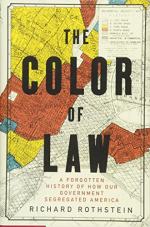
|
| Name: _________________________ | Period: ___________________ |
This test consists of 15 multiple choice questions and 5 short answer questions.
Multiple Choice Questions
1. Why was Stuyvesant Town not integrated, even though New York state forced the development to admit African Americans?
(a) Whites there threatened violence against black families.
(b) By the time the state won its case, the wait list was already full.
(c) Black families refused to move there.
(d) The rents were too high for African-American families to afford.
2. When was the first Great Migration that brought black families north?
(a) In the 1920s.
(b) During World War II.
(c) During World War I.
(d) In the 1890s.
3. What is reverse redlining?
(a) Making exploitative loans to black families.
(b) Making black families live near industrial areas.
(c) Keeping black families out of certain neighborhoods.
(d) Demolishing black neighborhoods for highways.
4. What does Rothstein say the American myth that hard work leads to success overlook?
(a) Automation.
(b) Systemic discrimination.
(c) Income inequality.
(d) Wage stagnation.
5. What does Rothstein say was a quick and easy segregation problem to solve?
(a) School segregation.
(b) Workplace discrimination.
(c) Bus seating segregation.
(d) Salary discrimination.
6. What does Rothstein call the practice of demolishing black neighborhoods in order to make way for white families?
(a) Rezoning.
(b) Slum clearance.
(c) Redistribution of real estate.
(d) Eminent domain.
7. How does Rothstein suggest reforming the Section 8 program?
(a) Ending the program.
(b) Limiting recipients to descendants of slaves.
(c) Giving subsidies to more people.
(d) Giving recipients larger subsidies.
8. For white families who bought homes in Levittown in 1948, how much value did they derive from appreciation?
(a) $200,000.
(b) $125,000.
(c) $75,000.
(d) $20,000.
9. What was Houston’s “Race Restriction Areas” map used for?
(a) De-integrating Houston’s neighborhoods.
(b) Limiting where whites could build.
(c) Limiting where blacks could find affordable housing.
(d) Integrating Houston’s new developments.
10. How does Rothstein characterize the relationship between the wealth of parents and the wealth of their children?
(a) Inverted proportion.
(b) Consistent.
(c) Linear.
(d) Unrelated.
11. What right did the National Labor Relations Act of 1935 give to unions?
(a) The right to deny membership to African Americans.
(b) The right to get federal work training.
(c) The right to boycott.
(d) The right to strike.
12. What percent of white families’ income did black families have, in 2017 when Rothstein published The Color of Law?
(a) One fifth.
(b) One third.
(c) One tenth.
(d) One quarter.
13. How were black families kept in the employment they were forced to take after reconstruction?
(a) They were threatened with murder.
(b) They were misled.
(c) They were bound in chains of debt.
(d) They were deceived.
14. According to Rothstein, what purposes did local governments seize black neighborhoods for?
(a) Airports and subway systems.
(b) Parks and highways.
(c) Industrial development.
(d) Private development.
15. Who does Rothstein say spread the word that Bill Myers, an African-American veteran, had moved into the Levittown in Pennsylvania?
(a) The postman.
(b) Housewives.
(c) Local builders.
(d) Kids.
Short Answer Questions
1. What does Rothstein say happened to George Romney, Secretary of Housing and Urban Development, when he started a program called Open Communities to deny federal funds to localities that still had racially restrictive covenant and exclusionary zoning ordinances?
2. How does Rothstein characterize the qualities any solution to America’s racism will have to have?
3. Where did the American Friends Service Committee (AFSC) find financing for an integrated development?
4. What was the condition that led the FHA to finally back the UAW’s development in Milpitas?
5. What does Rothstein suggest as a realistic remedy to systemic housing discrimination?
|
This section contains 631 words (approx. 3 pages at 300 words per page) |

|




